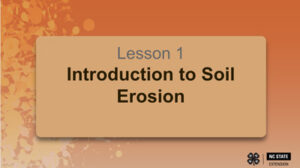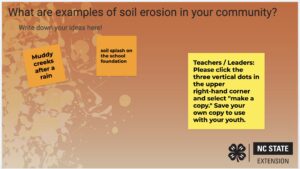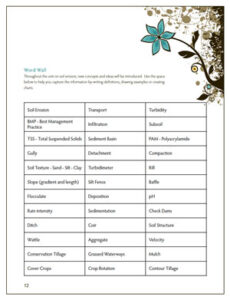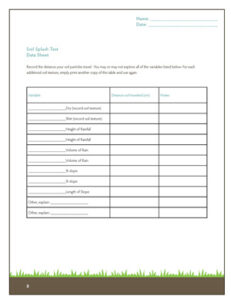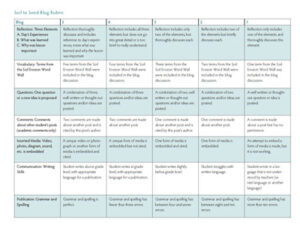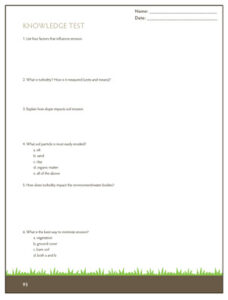Lesson 1: Introduction to Soil Erosion
Learner Outcomes
Students will broadly explore soil erosion to understand the physical mechanisms behind the process of erosion and the impacts that sediment has on water quality. Students will form a scientific learning community and share their ideas and findings through a blog.
Success Indicator
Describe how erosion impacts water quality.
Skill Level
Advanced; ages 14-18
Time Needed
One 90-minute class or two 45-minute classes
Next Generation Science Standards
Earth and Human Activity (HS-ESS3-1.)
Construct an explanation based on evidence for how the availability of natural resources, the occurrence of natural hazards, and changes in climate have influenced human activities.
Life Skills
Teamwork, Critical Thinking, Record Keeping, Communication
Materials
- Lesson One Slides
- Computer
- Projector / TV
- Internet access
- Rain splash video
- Rill Video
- Copies of Soil Splash Test handout
- 20-30 (depending on group size), 16-oz paper cups
- 4-5, 10, or 15ml pipettes
- 4-5 turkey basters
- 10-15 (depending on group size) cups of sandy soil
- 10-15 (depending on group size) cups of clayey soil
- Water
- Copies of the Word Wall
Logistics Note
Students will be asked to work in teams of 5 or 6 students on a number of assignments throughout this curriculum.
Lesson Slides
Click on “File” and then select “Make a Copy ” of the lesson one slide deck to use it with your youth.
Introduction
Introduction
Soil erosion is the process of wind and water moving soil particles from one location and transporting and depositing them elsewhere. Erosion is a natural occurrence, shaping sand dunes, creating river deltas, or carving out enormous rock features like the Grand Canyon.
Humans, however, have dramatically accelerated this process through agricultural practices, mining, logging and clearing, and grading for construction. These activities can cause detrimental effects on the environment, degrading water quality, compacting the soil, limiting water infiltration, removing vegetation, and exposing the soil surface, thereby increasing both runoff and erosion. Erosion rates are usually higher on lands that are denuded and reshaped for urban development, than on agricultural land. Sedimentation is the gravitational deposition of transported materials in flowing or standing water. Sediment can carry polluting chemicals, destroy fish habitat, decrease the storage capacity of water bodies, and increase the risk of flooding. Deposition of sediment on roads, and in-stream channels, reservoirs, lakes, estuaries, and harbors, reduces recreational and municipal usefulness and may require expensive removal operations. Soil erosion reduces the productivity of agricultural lands by removing topsoil, exposing less desirable subsoil. This results in a loss of organic matter and nutrients causing a reduction of fertility and water-holding capacity.
Mechanics of Soil Erosion
Erosion occurs in two steps: detachment of the soil particle and transportation of the soil particle down slope.
The physical impact of a raindrop on unprotected soil serves as the primary detachment mechanism, loosening soil particles and freeing them to be transported. When a raindrop strikes a surface, the force of the impact acts to destabilize the particles. The kinetic force disrupts soil aggregates, shattering them into individual soil particles. The loosened particles are then easily removed by runoff water. Dispersed soil may wash into soil surface pores, forming a crust that inhibits the emergence of seedlings and encouraging rapid runoff from subsequent rain events. Soil particle transport primarily occurs through water runoff across the land surface, causing sheet erosion. Soil particles are transported as the sediment is suspended in water and travels down slope. The rate of soil detachment and transport depends on soil texture, slope, vegetation, and rainfall.
Factors Affecting Soil Erosion
Soil Texture: Soil texture refers to the size of soil particles. Sand is the largest-sized particle, followed by silt, with clay being the smallest sized soil particle. Of all the soil particles, silt-sized particles erode most easily. Sand has large pore spaces that allow for a higher rate of infiltration. Clay particles, when wetted, become sticky and cohesive. These clay particles bind to each other becoming more difficult to dislodge and translocate.
Slope (length and steepness): Erosion can occur at different rates depending on the slope of the land. The steeper the slope, the greater the velocity of the water flowing across the surface and its capacity to transport and erode the soil. Increase the length of the slope and the erosive energy of the water increases.
Vegetation: Vegetation is the number one way to control erosion. Vegetative cover acts as a barrier that protects the soil particles from raindrop impact. Establishing grassed expanses provides a fast and effective measure to slow the velocity of water and allow sediment to drop out of suspension. Having a leaf canopy from trees, debris, and litter on a forest floor can reduce the impact on soil caused by the raindrops.
Rainfall (duration and intensity): Rainfall presents two parameters to consider: 1.) the rain intensity, or how hard the rain falls, and 2.) the length of time it rains. Overall, the amount of rain that falls and how quickly it falls determines how fast soils become saturated and runoff begins.
The combination of factors listed above determines the amount of erosion that will occur as well as the amount of sediment that may be transported and deposited elsewhere.
What is Erosion?
Experience: What is Erosion?
Begin the unit of study on soil erosion by asking students to pause and visualize examples of erosion.
- Ask them to think about their neighborhoods, the drive to school, anywhere they visit throughout their day where they might have seen evidence of erosion.
- Give them a few minutes to write down their ideas (Jamboard) and have them answer the daily opening questions listed above.
- Furnish students with the Word Wall handout.
- Explain that the Word Wall is a tool that enables them to organize their learning by recording important definitions related to soil erosion.
- Teachers may also instruct students to use a science journal to document these definitions.
Encourage students to share some of their thoughts; this will reveal their level of understanding and prompt the development of a deeper discussion of soil erosion throughout the unit.
- As students give their answers, record their ideas on the chalkboard.
- If not all of the basic soil erosion concepts are voiced, supplement the conversation with the information described in the Background Information section and the bullets below.
- Be sure to describe how soil erosion occurs and why it is important to study. Students will delve deeper into these concepts throughout the rest of the unit.
Ideas the students might mention or that you could suggest, include:
What is soil erosion?
- The movement of soil from its source by wind or water to another location.
How does soil erosion occur?
- Soil particles are detached by raindrops (sometimes wind, but mostly through rain events) and transported down slope.
- Rates of erosion depend on slope, slope length, soil texture, vegetation, and rainfall.
What role do humans play in this process?
- Humans can accelerate the erosion process through mismanagement of agricultural lands and the clearing activities caused by development, mining, or logging.
Why is it important to limit soil erosion?
- Loss of plant essential nutrients from the eroded topsoil reduces the productivity of agricultural lands and in urban development makes it hard to establish vegetation like lawns.
- Sediment can carry polluting chemicals, destroy fish habitats, decrease the storage capacity of water bodies and increase the risk of flooding.
- Sedimentation reduces recreational and municipal usefulness of water bodies and may require expensive dredging.
After discussing student’s initial ideas about soil erosion, watch the video on soil erosion and talk through any observations they have. Then, introduce the activities they will be doing throughout the soil erosion unit, from exploring the basic physics of soil movement and soil properties to designing experiments that will determine the best practices to control soil erosion and sedimentation, helping to protect water quality. Outline expectations for their learning, beginning by asking students about their own expectations and interest in the subject. Inform them they will be expected to work as a team of scientists, continually observing and asking questions and communicating their ideas to each other. The students will be asked to record their ideas and experiences through a classroom blog or science journal.
Soil Erosion Jamboard
Use this jamboard to engage youth in brainstorming their ideas around soil erosion.
Teachers / Leaders: Please click the three vertical dots in the upper right-hand corner and select “make a copy.” Save your own copy to use with your youth.
Word Wall
The Word Wall: The Word Wall is a matrix of definitions and terms that will be covered throughout the curriculum. Students should define different concepts and ideas through writing, drawing, and graphing. Teachers can have the students complete the Word Wall as a graded assignment and measure student knowledge based on their given answers.
Digital World Wall
Use this google slide digital notebook to keep track of all the soil to seed words and definitions.
Soil Erosion
Watch what happens when it rains on unprotected soil.
Start of Erosion
Experience: The Start of Soil Erosion
- Show the students the “Rain Splash” video.
- Ask the students to report on their observations. Questions throughout the video should prompt students to focus on key points. Teachers may want to show the video two or three times.
Teachers might consider asking questions like:
- “What happened to the soil?”
- “How did the speed of the rain drop affect the soil movement?”
- “What role did soil particle size play in the dispersal distance?”
- “What happened when the larger rain drop hit the soil?”
- “Have you seen examples of this before?”
- “Why do you think this is important?”
- “What does this have to do with soil erosion?”
Explain that the video shows the mechanics of soil erosion, detachment, and transport. The physical impact by the raindrops causes the soil aggregates to break apart, leaving fine soil particles that can be easily transported away by water runoff. In the videos, the finer sand particles travel farther than the coarser particles because they are lighter and easier to move. The students will have an opportunity to determine this themselves.
Rainsplash
Watch this video that uses high speed photography to show the impact of water falling onto soil.
Soil Splash Test
Experience: Soil Splash Test
What conditions cause soil erosion? How do different soil erosion factors affect soil displacement? How can you play a role in managing soil erosion? Complete this experiment to discover what variables play a role in the erosion of soil.
- In groups of two to three, place about a quarter cup of dry soil (one clay and one sand) in a small dish or plate. Alternatively, cut off the bottom of a paper cup to the height of 1-inch and fill it with soil.
- Using a large piece of white paper (easel pad) placed on the floor (or the white back of a laminated poster/piece of paper), place the plate with the dry sandy soil in the center.
- Have one person from each group fill a pipette with water and from a height of about 4’ release the water from the pipette aiming for the soil pile. Record your measurements of how far soil is displaced when it is dry.
- Continue to rain on the soil until the point of saturation. Once the soil is saturated, observe soil particles that have been displaced from the plate onto the white paper.
- Measure the distance that some of the particles have traveled using a ruler and record your findings on the Splash Test Data handout.
- You may also choose to draw concentric circles on the paper, like a bullseye, with the rings providing a scale to measure the distance traveled by the soil particles.
- Further, explore variables that affect soil displacement by changing:
- The height of the pipette (rainfall)
- The volume of rainfall (use a different water dropper, like a turkey baster)
- The slope of the splash test
- Observe differences in splash effect between the variables. Plot your measurements on the Splash Test Data Sheet and possibly on the chalkboard as well to share the results of their experimentation with the entire class.
- Repeat this experiment with another soil texture and record measurements on another Soil Splash Test Data Sheet.
The soil splash test lends itself to multiple variations, as a group comes up with additional ideas to test. You might try additional soil textures or soils with well expressed or strong structures.
Soil Splash Test Data Sheet
Use this handout to capture the results of the soil splash activity.
Talking it Over: Soil Splash Test
Share …what you did
- What soils did you use in your experiment? What variables did you change? How did the different variables (height of rainfall, rain intensity, slope) affect soil dispersal?
- List the most surprising thing(s) you observed. Explain why you were surprised by these results.
Reflect …on the results
- Based on the results of your experiment, what factors cause significant erosion? Explain.
- Based on the results of your experiment, explain the importance of managing soil erosion.
Generalize …to your community
- Based on the results of the splash test, how, if at all, will you change the way you manage the soil at your school, your house, your community?
- Based on the results of your experiment, explain things you might look for when looking at sites that might be susceptible to erosion?
Apply …to your community
- Based on the knowledge you have gained from your experiment, how do you think soil should be managed to prevent erosion?
- Based on your new knowledge, what do you think you should do if you observe soil erosion occurring?
Rill Formation
Rill Formation
Next, show the students the video clip “Rill Formation” that illustrates the process of soil washing away and forming small channels called rills. Give the students an opportunity to silently reflect at the end of the video and offer to show it again. Allow them to share their ideas with a partner or small group and then ask for a whole class discussion of their findings. Questions that might focus their thinking could include:
- “What is happening to the soil?”
- “Where does the soil end up?”
- “What is this process called?”
- “Why is it important, why does it matter?”
- “How do humans affect this process?”
- “How are humans influencing the availability of fresh water?”
- “What bodies of water are impacted by sedimentation?”
Students should observe the water translocating the soil down slope, leaving behind larger particles like rocks. The soil that moves down slope settles at the bottom, a process called sedimentation. Students might notice rills or small channels beginning to form and the walls of these channels caving in and moving more soil off-site. The water, in the beginning, is cloudy and muddy from the fine soil particles and can be considered turbid. By the end of the video, most of the soil has eroded, leaving subsoil behind and clear water.
Encourage deeper conversations about our role in soil erosion and sedimentation. Have students discuss the human activities that cause erosion and sedimentation. Ideas should focus on construction and development and agricultural practices. In agriculture, soil erosion can happen when marginal lands (lands that are highly susceptible to erosion) are continuously farmed and conservation practices are not implemented. In the construction/land development context, erosion occurs when soil protection practices are not in place. Ask students to describe what bodies of water (streams, rivers, lakes, estuaries, wetlands) are affected by erosion and sedimentation and why it is important to maintain good water quality.
Rill Formation
Watch this simulation of a rain event to see how rills and gullies begin to form.
Soil Erosion Blog
The Soil Erosion Blog
Introduce the students to the concept of a classroom blog focused on soil erosion. Blogs are websites that contain text, video, photos, and audio postings on a particular subject. In the classroom, blogs offer a relevant way for students to create a scientific community amongst themselves and the public, contributing ideas on a topic of learning, asking questions, and commenting on each other’s postings. A blog allows teachers to assess student understanding and participation. A science journal can serve a similar purpose and provides a good alternative for those with limited Internet access. The public nature of a blog, however, opens student ideas for discussion with a potentially global audience, is well suited to multiple learning styles, encourages students to take pride in their work, fosters peer-to-peer interaction and learning, and allows mutual learning between teacher and students. If school policy limits blog use, consider password protecting it and inviting only students to participate. Teachers might collaborate with an English teacher or technology teacher to discuss document structure when blogging, Internet safety, or crediting information sources.
As part of the soil erosion project, ask the students to participate in the blog as scientists and be responsible for recording observations, recapping the events and ideas of the day, taking and using photographs or video, and providing feedback to their peers through commenting. When introducing the idea of a blog to the students, solicit their ideas on how they would like to use it and what elements they feel are important to include (photos, links to articles, grammatical considerations, and such) and use this information as the basis for assessment. A sample rubric (located at the end of this lesson) has been developed for teachers and students to provide expectations and guidelines for blog posting and as a grading tool. Also be sure to create a collective list of posting etiquette (language, no bullying, crediting sources).
A blog can be started using free online blogging software. Possibilities to consider include; Blogger, WordPress, or Live Journal. Teachers may prefer to set up one blog per class and have each blogger include his or her name as part of the post. Others may set up a blog per group. Teachers might pre-select a number of good science blogs to show as examples and highlight good features.
Blog Rubric
Use this rubric to support your students in developing their blog posts as well as evaluating their work.
Assessment
Knowledge Test
Pre-Test: Use this cumulative exam before beginning the curriculum to assess student levels of understanding and determine which areas they might focus their studying and as a way to show knowledge gain as a result of the curriculum instruction.
Learn More
Learn More
Hugh Hammond Bennett was born on a cotton farm in Anson County, North Carolina. After graduating from UNC-Chapel Hill, he took a position in the Bureau of Soils, within the U.S. Department of Agriculture. He began classifying and mapping soils throughout the Southeast and observing their productivity. He quickly noticed the impact soil erosion had on agricultural capacity and worked throughout his career to establish an awareness of what he considered a “national menace.” Bennett was a fierce advocate for soil conservation practices, urging farmers to employ measures such as contour farming and terracing to manage the soil. With the devastating effects of the Dust Bowl in 1935, Bennett urged Congress to pass the Soil Conservation Act establishing the first Soil Conservation Service, and he was named chief of the new agency. One of his lasting legacies is the development of soil and water conservation districts at the county level to promote stewardship of the soil at the local level.
- Have students conduct further research into the life of Hugh Hammond Bennett.
- Encourage students to contact their county Soil and Water Conservation District and interview the district director about the conservation work the district does. Students should compile a list of questions they are interested in knowing more about in preparation for the interview. They could report their findings on the blog.
- Ask students to research the Dust Bowl and present their findings.

